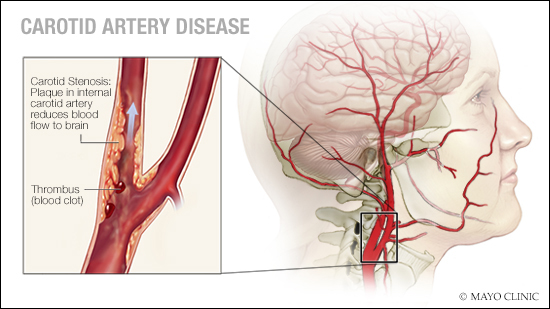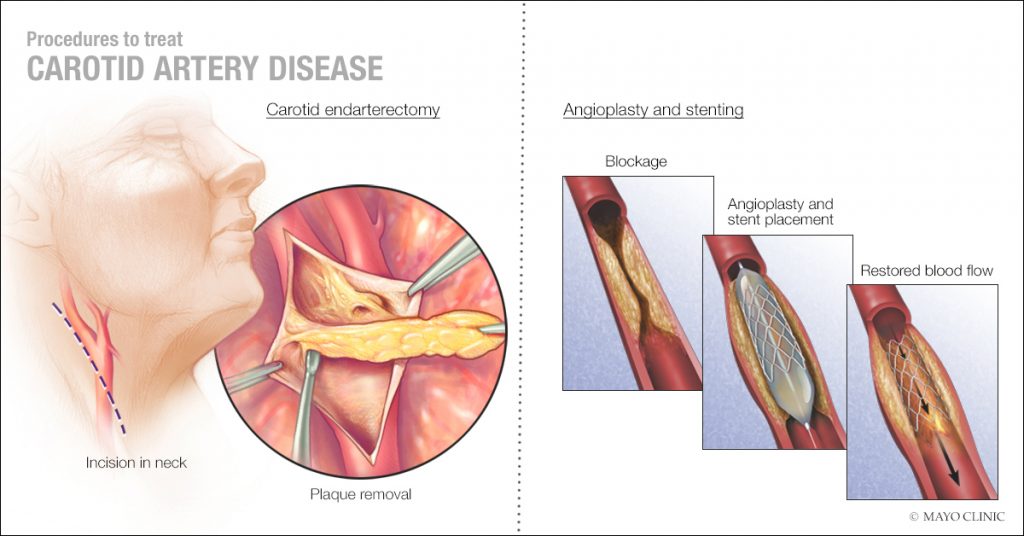-
Cardiovascular
Mayo Clinic Q and A: New treatment to open blocked carotid artery
 DEAR MAYO CLINIC: My husband has severe carotid stenosis. To lower his risk of a stroke, his health care provider recommended a procedure to open the blocked carotid artery. But then we learned that the procedure itself can put him at risk for a stroke. Are there other treatment options that don’t present a stroke risk?
DEAR MAYO CLINIC: My husband has severe carotid stenosis. To lower his risk of a stroke, his health care provider recommended a procedure to open the blocked carotid artery. But then we learned that the procedure itself can put him at risk for a stroke. Are there other treatment options that don’t present a stroke risk?
ANSWER: Carotid stenosis is a common cause of stroke, so it’s crucial that your husband be treated for his condition. Traditional treatments for carotid stenosis can pose a small risk of triggering a stroke. There is a new treatment, however, called transcarotid arterial revascularization, or TCAR, that uses a different approach to opening a blocked carotid artery. The risk of a stroke during that procedure may be lower than it would be with other methods.
Carotid stenosis occurs when fatty deposits, or plaques, block the carotid arteries — the blood vessels that deliver blood to your brain and head. The blockage increases stroke risk. A stroke is a medical emergency that occurs when the blood supply to the brain is interrupted or significantly reduced. Stroke is the leading cause of permanent disability in the U.S.
Carotid stenosis is particularly dangerous because as plaque builds up inside a carotid artery, the plaque becomes increasingly unstable, and the plaque blockage bursts, releasing pieces of plaque into the bloodstream. Those pieces are carried up into the brain, where they can become lodged in a blood vessel and lead to a stroke.
Treatment for severe carotid stenosis involves eliminating the artery blockage. The most common way to do that is with a surgery called “carotid endarterectomy.” It’s performed by making an incision along the front of the neck, opening the carotid artery and removing the plaque.

If the blockage is too difficult to reach using surgery, or if a patient has other health conditions that make surgery too risky, another option is carotid angioplasty and stenting. For this procedure, a catheter with a tiny balloon at the tip is threaded through an artery in the groin up to the area of the clog. The balloon is inflated to widen the artery, pushing the plaque to the side, and a small wire mesh coil, called a stent, is inserted to keep the artery open.
During both procedures, there is a risk that a stroke could occur if, as the surgeon is working, plaque is dislodged and travels to the brain. During angioplasty, there’s also a risk that blood clots may form on the catheter or plaque may break loose and travel to the brain, possibly leading to a stroke.
The new TCAR technique is a hybrid of the two techniques. It involves making a tiny incision at the base of the neck and, from there, inserting a stent into the carotid artery. While the stent is being placed, blood flow through the carotid artery is reversed temporarily. This is accomplished by inserting a small device into the carotid artery that removes the blood and reroutes it to a vein in the leg via a circuit outside the body.
That external circuit contains a pump to move the blood and a filter to remove any plaque that may break free from the artery during the procedure. With TCAR, a stent can be placed to open the artery and relieve the blockage, while the brain is protected from any debris that could lead to a stroke.
Research has shown that the temporary reversal of blood flow during TCAR is safe. And the treatment has been shown to have a lower stroke risk than traditional stenting or surgery. Although it’s not the best option for everyone, TCAR can be an attractive treatment alternative for many people who have severe carotid stenosis and are at high risk for stroke. — Dr. Andrew Oldenburg, Vascular Surgery, Mayo Clinic, Jacksonville, Florida
****************************
Related Articles
- Mayo Clinic Minute: What women should know about stroke published 10/29/18
- Mayo Clinic Minute: Know the facts on stroke published 5/3/18







